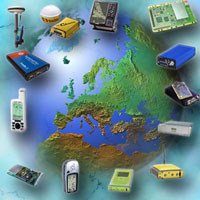If you wish to contribute or participate in the discussions about articles you are invited to contact the Editor
EGNOS Receivers
| EGNOS | |
|---|---|
| Title | EGNOS Receivers |
| Author(s) | Edited by GMV |
| Level | Basic |
| Year of Publication | 2011 |
To receive EGNOS signals an EGNOS compatible receiver is required. There are many receivers available on the market from a variety of manufacturers.[1]
An EGNOS receiver is like a GPS receiver but with special software inside that allows the receiver to lock onto the code used by the EGNOS satellites and compute the EGNOS corrections to the GPS signals. Apart from this, an EGNOS receiver is just like a GPS receiver. This means that it can pick up GPS signals as well. An EGNOS receiver is the same size as a GPS receiver and uses the same type of antenna.
Receiver types
According to the European GNSS Agency[2], the selection of the EGNOS receiver to use will depend on the specific application, the functionalities needed, and the integration constraints. In particular, it is necessary to check whether the receiver processes EGNOS correctly, and if its interfaces allow the application to retrieve the required data.
There are different technologies to use as basis upon which design an EGNOS-enabled receiver, namely, chipsets, hybrid components and auxiliary cards:[2]
- Chipsets: the EGNOS solution is embedded in one or two components that are installed in a circuit board. Special care is to be put with the RF interface. This solution is the least expensive.
- Hybrid components: a single component includes RF functions and data processing. With a cost higher than the chipset solution, the integration is simpler.
- Auxiliary cards (piggybacks): all the RF and processing functions are included in a single card designed to be attached to the main board. Although this is the highest cost solution, is also the best one for embedded applications.
Communications protocols
Receiver manufacturers tend to provide output data in a combination of proprietary and standardized open formats, the most common of which include NMEA, RTCM, NTRIP, SiSNET and RINEX (Receiver INdependent EXchange).
Manufacturer’s specifications
As EGNOS is interoperable with other SBAS, those receivers implementing the SBAS standards will take benefit of it. In practice, many receivers indicate its compatibility with SBAS with the tags "WAAS Capable" or "WAAS Enabled", after the first operational SBAS, deployed by the US government. "WAAS Capable" usually means that the SBAS functions are switched off in the default receiver configuration; the user would have to turn them on at least once. On the contrary, "WAAS Enabled" usually indicates that the SBAS features are set in the initial configuration.[2]
It is important to bear in mind that navigation services are developing swiftly, so it is vital to keep in pace with international standards.[3]
Safety-of-Life and Open Service Receivers
For the Safety-of-Life (SoL) service,[4] the EGNOS user equipment shall be compliant (certified) against several standards. For instance, civil aviation SBAS equipment shall demonstrate (see SBAS standards):
- Full compliance to RTCA SBAS MOPS DO-229 (airborne equipment).
- Full compliance to the RTCA SBAS MOPS 228 and 301 (antenna requirements).
- Compliance to RTCA TSO (C190, C145b, C146b) for SBAS equipment.
- Compatibility to other avionics equipment, in particular Flight Management Systems (FMS).
The SoL civil aviation certified equipment is in the highest rank with respect its cost. There exist a large number of certified receivers manufacturers worldwide both in the US (GARMIN, Honeywell, Rockwell Collins, General Avionics, etc) and in Europe (see complete list in EASA homepage[5]).
The Open Service (OS)[6] targets low cost, general purpose GNSS equipment that uses the SBAS SIS to provide the user with an enhanced accuracy performance in comparison with the one provided by a standalone GPS device. In comparison with the certification requirements of the user equipment above, user equipment is not necessarily compliant with the RTCA MOPS DO 229 processing rules, but might only make use of the processing algorithms that render the accuracy corrections provided by the SBAS SIS.
Helios[7] produced a list of receivers compatible with EGNOS as part of a market study completed in 2008 on behalf of the GNSS Supervisory Authority.[8] It is a non-exhaustive list providing SBAS capabilities of a set of receivers and, when possible, the GNSS chipset used. This information is available in the EGNOS compatible receiver list produced by the GSA. According to this report, Many devices are suitable, and marketed, for more than one of the market segments identified here. Outdoor recreation devices, for example, cross over into the maritime and general aviation segments.
The survey divided the receivers into several categories, depending on the level of processing of the SBAS information:[8]
- Category 1: Full use of SBAS corrections.
- Category 2: Capability of receiving the signal from the SBAS satellites.
- Category 3: The receiver is known to be SBAS compatible, but the receiver does not make use of this ability and does not process the augmentation data. Products in this category would require a more extensive receiver firmware upgrade to make use of SBAS.
- Category 4: Receivers for which the SBAS capability of the device/chipset is unknown.
In any case, it should be noted that this classification is not aligned with the equipment operational classes defined in the MOPS RTCA DO 229 D.
Notes
References
- ^ ESA Web site on EGNOS receivers
- ^ a b c EGNOS Portal on EGNOS receivers
- ^ ESA web site on EGNOS Receiver Manufacturers
- ^ EGNOS Safety of Life Service Definition Document
- ^ List of ETSO Authorisations (European Aviation Safety Agency)
- ^ EGNOS Open Service Definition Document
- ^ Helios Home Site
- ^ a b EGNOS Receiver Consultation produced by Helios, Executive Summary and Key Conclusions


